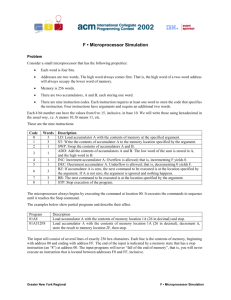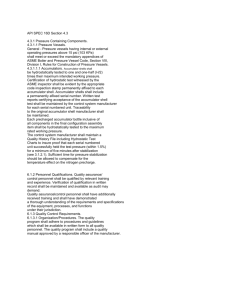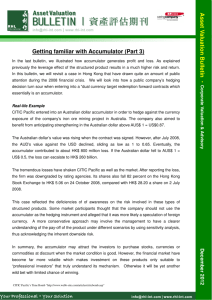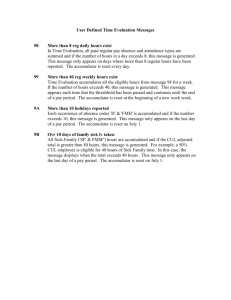Guidelines for Selection, Installation and Operation
advertisement
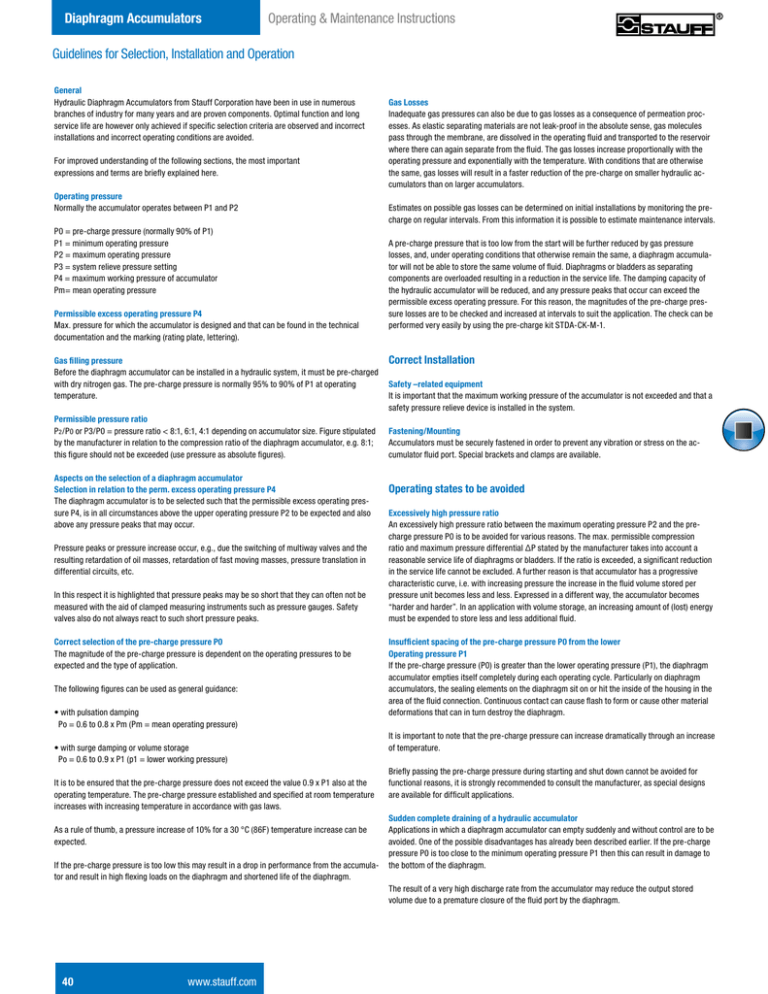
Diaphragm Accumulators Operating & Maintenance Instructions Guidelines for Selection, Installation and Operation General Hydraulic Diaphragm Accumulators from Stauff Corporation have been in use in numerous branches of industry for many years and are proven components. Optimal function and long service life are however only achieved if specific selection criteria are observed and incorrect installations and incorrect operating conditions are avoided. For improved understanding of the following sections, the most important expressions and terms are briefly explained here. Operating pressure Normally the accumulator operates between P1 and P2 P0 = pre-charge pressure (normally 90% of P1) P1 = minimum operating pressure P2 = maximum operating pressure P3 = system relieve pressure setting P4 = maximum working pressure of accumulator Pm= mean operating pressure Permissible excess operating pressure P4 Max. pressure for which the accumulator is designed and that can be found in the technical documentation and the marking (rating plate, lettering). Gas filling pressure Before the diaphragm accumulator can be installed in a hydraulic system, it must be pre-charged with dry nitrogen gas. The pre-charge pressure is normally 95% to 90% of P1 at operating temperature. Permissible pressure ratio P 2 /P 0 or P3/P0 = pressure ratio < 8:1, 6:1, 4:1 depending on accumulator size. Figure stipulated by the manufacturer in relation to the compression ratio of the diaphragm accumulator, e.g. 8:1; this figure should not be exceeded (use pressure as absolute figures). Aspects on the selection of a diaphragm accumulator Selection in relation to the perm. excess operating pressure P4 The diaphragm accumulator is to be selected such that the permissible excess operating pressure P4, is in all circumstances above the upper operating pressure P2 to be expected and also above any pressure peaks that may occur. Pressure peaks or pressure increase occur, e.g., due the switching of multiway valves and the resulting retardation of oil masses, retardation of fast moving masses, pressure translation in differential circuits, etc. In this respect it is highlighted that pressure peaks may be so short that they can often not be measured with the aid of clamped measuring instruments such as pressure gauges. Safety valves also do not always react to such short pressure peaks. Correct selection of the pre-charge pressure P0 The magnitude of the pre-charge pressure is dependent on the operating pressures to be expected and the type of application. The following figures can be used as general guidance: • with pulsation damping Po = 0.6 to 0.8 x Pm (Pm = mean operating pressure) • with surge damping or volume storage Po = 0.6 to 0.9 x P1 (p1 = lower working pressure) It is to be ensured that the pre-charge pressure does not exceed the value 0.9 x P1 also at the operating temperature. The pre-charge pressure established and specified at room temperature increases with increasing temperature in accordance with gas laws. As a rule of thumb, a pressure increase of 10% for a 30 °C (86F) temperature increase can be expected. If the pre-charge pressure is too low this may result in a drop in performance from the accumulator and result in high flexing loads on the diaphragm and shortened life of the diaphragm. Gas Losses Inadequate gas pressures can also be due to gas losses as a consequence of permeation processes. As elastic separating materials are not leak-proof in the absolute sense, gas molecules pass through the membrane, are dissolved in the operating fluid and transported to the reservoir where there can again separate from the fluid. The gas losses increase proportionally with the operating pressure and exponentially with the temperature. With conditions that are otherwise the same, gas losses will result in a faster reduction of the pre-charge on smaller hydraulic accumulators than on larger accumulators. Estimates on possible gas losses can be determined on initial installations by monitoring the precharge on regular intervals. From this information it is possible to estimate maintenance intervals. A pre-charge pressure that is too low from the start will be further reduced by gas pressure losses, and, under operating conditions that otherwise remain the same, a diaphragm accumulator will not be able to store the same volume of fluid. Diaphragms or bladders as separating components are overloaded resulting in a reduction in the service life. The damping capacity of the hydraulic accumulator will be reduced, and any pressure peaks that occur can exceed the permissible excess operating pressure. For this reason, the magnitudes of the pre-charge pressure losses are to be checked and increased at intervals to suit the application. The check can be performed very easily by using the pre-charge kit STDA-CK-M-1. Correct Installation Safety –related equipment It is important that the maximum working pressure of the accumulator is not exceeded and that a safety pressure relieve device is installed in the system. Fastening/Mounting Accumulators must be securely fastened in order to prevent any vibration or stress on the accumulator fluid port. Special brackets and clamps are available. Operating states to be avoided Excessively high pressure ratio An excessively high pressure ratio between the maximum operating pressure P2 and the precharge pressure P0 is to be avoided for various reasons. The max. permissible compression ratio and maximum pressure differential ΔP stated by the manufacturer takes into account a reasonable service life of diaphragms or bladders. If the ratio is exceeded, a significant reduction in the service life cannot be excluded. A further reason is that accumulator has a progressive characteristic curve, i.e. with increasing pressure the increase in the fluid volume stored per pressure unit becomes less and less. Expressed in a different way, the accumulator becomes “harder and harder”. In an application with volume storage, an increasing amount of (lost) energy must be expended to store less and less additional fluid. Insufficient spacing of the pre-charge pressure P0 from the lower Operating pressure P1 If the pre-charge pressure (P0) is greater than the lower operating pressure (P1), the diaphragm accumulator empties itself completely during each operating cycle. Particularly on diaphragm accumulators, the sealing elements on the diaphragm sit on or hit the inside of the housing in the area of the fluid connection. Continuous contact can cause flash to form or cause other material deformations that can in turn destroy the diaphragm. It is important to note that the pre-charge pressure can increase dramatically through an increase of temperature. Briefly passing the pre-charge pressure during starting and shut down cannot be avoided for functional reasons, it is strongly recommended to consult the manufacturer, as special designs are available for difficult applications. Sudden complete draining of a hydraulic accumulator Applications in which a diaphragm accumulator can empty suddenly and without control are to be avoided. One of the possible disadvantages has already been described earlier. If the pre-charge pressure P0 is too close to the minimum operating pressure P1 then this can result in damage to the bottom of the diaphragm. The result of a very high discharge rate from the accumulator may reduce the output stored volume due to a premature closure of the fluid port by the diaphragm. 40www.stauff.com
